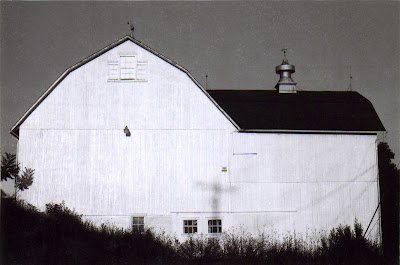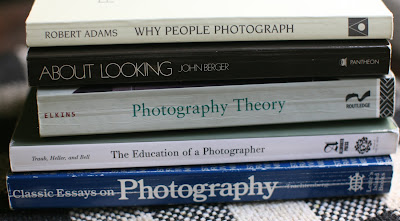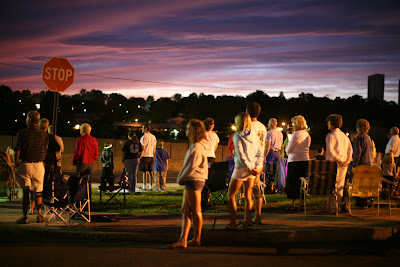 from Hallowed Places series. Philadelphia 2009
from Hallowed Places series. Philadelphia 2009
 ghost bike. New York City 2009
ghost bike. New York City 2009White painted Ghost Bikes are set up to memorialize the location of bicyclists who have been killed in collisions with vehicles. This one is in Greenwich Village.
Dance or go home!


I've been hearing about the Sundae parties at the Piazza for a while now, and finally checked it out yesterday. I was blown away by the electric atmosphere and the genuine fun! What a fabulous family experience... so many kids of all ages getting their groove on and having a wonderful time. I shot two packs of Polaroid film and love the results I got mostly following the Hula Hoop dancers.
Sundae Philadelphia


I've been hearing about the Sundae parties at the Piazza for a while now, and finally checked it out yesterday. I was blown away by the electric atmosphere and the genuine fun! What a fabulous family experience... so many kids of all ages getting their groove on and having a wonderful time. I shot two packs of Polaroid film and love the results I got mostly following the Hula Hoop dancers.
Sundae Philadelphia
 April Harrison at Art Jaz Gallery, Philadelphia
April Harrison at Art Jaz Gallery, PhiladelphiaArt Jaz Gallery
53 N. 2nd Street
Philadelphia, Pa 19106
Art Jaz Gallery
 White Barn. Germansville, Pa. 2009
White Barn. Germansville, Pa. 2009I have become disillusioned with the digital medium. Not the first time and probably not the last. I've been fighting with my digital demons for quite a while now. The constant checking of the LCD monitor, obsessing about the histogram, dealing with artifacts and post processing devils. It has felt less and less like art to me, and more about the computer and technology. It has become too easy and unchallenging. It's like buying the absolute perfect Jersey Tomato at a farm stand, versus growing your own tomato from seed. Both tomatoes are really wonderful, but the home grown tomato will always provide more satisfaction.
With very few exceptions (for some must finish digital projects), I am going to shoot nothing but film for the rest of the summer. My Olympus OM-1 and the Hasselblad, using primarily Kodak 125 Plus-X film. It is a harsh lesson in patience and letting go of the control that is so much a part of the digital addiction. Waiting days or weeks to see what I have on my negatives. But oh so rewarding... I got back three rolls of film tonight and the results completely confirm my decision. Nothing I could shoot with a digital camera can compare to the tonal range of the Plus-X film straight out of the camera. I can't wait to get back into the darkroom in September and make prints of these images.
 Quartz Veins. Appalachian Trail, 2009
Quartz Veins. Appalachian Trail, 2009
 3 Trees by Kim
3 Trees by KimA Lakota woman named Elaine Jahner once wrote that what lies at the heart of the religion of hunting peoples is the notion that a spiritual landscape exists within the physical landscape. To put it another way, occasionally one sees something fleeting in the land, a moment when line, color, and movement intensify and something sacred is revealed, leading one to believe that there is another realm of reality corresponding to the physical one but different.
Barry Lopez
Arctic Dreams
 Minor White
Minor White"Self-discovery through a camera?
I am scared to look for fear of discovering how shallow my Self is!
I will persist however...
because the camera has it's eye on the exterior world.
Camera will lead my constant introspection back into the world..."
Minor White
Rites & Passages
If you read this blog you know about my passion for sequential and series based photography. My Roadside Memorials and Collected Horizons studies are examples of long term projects that become obsessive and purpose driven searches for similar images in the same context. For me, sequences are the essence of photographic expression and meaning. They slow me down, requiring patience and consistency, which in turn leads to greater depth and substance in my art. Not even the instant gratification of digital technology can overcome the methodical requirements of long term sequence projects. These projects must be nurtured and tended to with the mindset of a farmer.
I belong to a local Community Supported Agriculture (CSA) farm in Horsham, Pa. called Pennypack Farm. (If you do not know what a CSA is, there is a link at the bottom of this post that explains it.) Every Monday afternoon I pick up my weekly share at the farm from the selection of produce that was just harvested that morning. Every Monday night when I get home from work the first thing I do is photograph the share. Nothing fancy. I just spread out the vegetables according to variety on my weathered wood deck.
I love the pattern that is developing in these portraits. This is a weekly representation of what is being grown at the farm. Every portrait is taken at approximately the same time of day, exactly seven days apart, and at virtually the same amount of time since the vegetables were harvested from the ground.Timing, repetition, and patience are essential parts of successful farming, and this series plays off of those elements. Individually these images are semi-interesting displays of vegetables. As a continuous sequence they represent so much more than pure documentation. This is the art of farming. These are the rewards of patience and diligence. We observe the cycles of the growing season.
The following images are four consecutive weekly portraits of my shares from the farm. The last photograph is what I brought home today. There should be at least twenty images by the end of the season. The link below will allow you to follow the entire season at it develops.




CSA 2009 Series
What is CSA?
I belong to a local Community Supported Agriculture (CSA) farm in Horsham, Pa. called Pennypack Farm. (If you do not know what a CSA is, there is a link at the bottom of this post that explains it.) Every Monday afternoon I pick up my weekly share at the farm from the selection of produce that was just harvested that morning. Every Monday night when I get home from work the first thing I do is photograph the share. Nothing fancy. I just spread out the vegetables according to variety on my weathered wood deck.
I love the pattern that is developing in these portraits. This is a weekly representation of what is being grown at the farm. Every portrait is taken at approximately the same time of day, exactly seven days apart, and at virtually the same amount of time since the vegetables were harvested from the ground.Timing, repetition, and patience are essential parts of successful farming, and this series plays off of those elements. Individually these images are semi-interesting displays of vegetables. As a continuous sequence they represent so much more than pure documentation. This is the art of farming. These are the rewards of patience and diligence. We observe the cycles of the growing season.
The following images are four consecutive weekly portraits of my shares from the farm. The last photograph is what I brought home today. There should be at least twenty images by the end of the season. The link below will allow you to follow the entire season at it develops.




CSA 2009 Series
What is CSA?
 Untitled #1. Nicolai Howalt (2009)
Untitled #1. Nicolai Howalt (2009)Nicolai Howalt: Car Crash Studies
Bruce Silverstein Gallery
September 10, 2009 - October 24, 2009
Opening: Thursday, September 10th, 6 - 8pm
Nicolai Howalt's website
 The Light by Patty Cake Melting
The Light by Patty Cake Melting Photographing Light...
Expose a roll or two of film so that if someone viewing the resulting prints were to be asked, 'what is the subject?' they would reply, 'light'.
Philip Perkis
Teaching Photography: notes assembled
I was very interested in the Edgar Martins photo-essay in the New York Times, Ruins of the Second Guilded Age, mostly because it was vaguely similar to my own study of abandoned architecture. A few people had even sent me links to it making sure I had seen it. Now it is the subject of controversy and scandal because the NYT has removed the essay from it's web site after it became clear that the photos were digitally manipulated. The original essay notes claimed that Martin uses long exposures, but no digital manipulation of his images. That claim was quickly debunked on several blogs...
Photo District News
Art Most Fierce
It annoys the daylights out of me when photographers lie about the amount of digital manipulation in an image. When the hell are photographers going to get over the shame and self consciousness of the art vs.non art elements of photography as a medium. This goes back to the original debates of the pictorialists vs. straight photography, and continues today with bold faced lies about Photoshopped alterations being portrayed as documentary truth.
I'm not a fan of digital manipulation. I don't own the full version of Photoshop and never intend to buy it.I use basic Photoshop Elements, because the only thing I want to do with my images is no more than what I would be able to do in a darkroom. I want my digital photography to be as close to the authenticity of film photography as possible. That doesn't imply a right or wrong judgement upon digital manipulation, it is just the way I choose to approach my craft.
Those who choose to digitally alter and filter their work have every right to do so. Computer technology has opened up a vast new world of photographic expression and potential. Go for it! But please, don't lie about it and shamefully pass it off as straight photography. By doing so you are hindering the entire photographic medium, and sending us back to the dark ages of photography.
Photo District News
Art Most Fierce
It annoys the daylights out of me when photographers lie about the amount of digital manipulation in an image. When the hell are photographers going to get over the shame and self consciousness of the art vs.non art elements of photography as a medium. This goes back to the original debates of the pictorialists vs. straight photography, and continues today with bold faced lies about Photoshopped alterations being portrayed as documentary truth.
I'm not a fan of digital manipulation. I don't own the full version of Photoshop and never intend to buy it.I use basic Photoshop Elements, because the only thing I want to do with my images is no more than what I would be able to do in a darkroom. I want my digital photography to be as close to the authenticity of film photography as possible. That doesn't imply a right or wrong judgement upon digital manipulation, it is just the way I choose to approach my craft.
Those who choose to digitally alter and filter their work have every right to do so. Computer technology has opened up a vast new world of photographic expression and potential. Go for it! But please, don't lie about it and shamefully pass it off as straight photography. By doing so you are hindering the entire photographic medium, and sending us back to the dark ages of photography.

Artists often describe themselves as self taught, which I generally assume to mean never having attended formal training at an art school or through an apprenticeship.
I describe myself as a self taught photographer. I have set my own curriculum plan over the years, and it has been quite intense. Certainly more chaotic and circular than I would have received at any school, but I prefer it that way.
At the heart of my self taught education is a continuum of reading everything I can get my hands on concerning the aesthetics of photography. If someone asked me how to become a photographer, I would say do three things.... (1)Take pictures of something (anything) everyday,(2) obsessively study the work of other photographers, and (3) read photography essays.
Essays, not photography manuals! Once you have a basic understanding of shutter speeds, apertures, ISO, etc, there is little need to read technical manuals, unless you are heading towards commercial photography. You will learn everything you need to know about technique by taking pictures everyday, learning from your mistakes and your victories.
But essays about aesthetics and vision and meaning are what feed us intellectually as artists, and push us in new directions. Most of my favorite essays are written by photographers whose work has had the most profound influence on my own work. The following list is what I consider to be the five best photography essays of all time, and I have read each of them dozens of times.They are about the subjects and concepts of photography that can't be taught, but must be felt and slowly absorbed through the skin through years of working with a camera. I will continue to read them over and over again, as each time I do they reveal something new to me.
The Camera Mind and Eye by Minor White
Photography at the Crossroads by Berenice Abbott
Understanding a Photograph by John Berger
The Reappearance of Photography by Walker Evans
Seeing Photographically by Edward Weston

I believe there is a critical relationship between my creative energy level and the amount of reading I do. I make the choice every day between spending time reading something that will add to and enhance my creativity, or watching something soul destroying on TV. It is so easy to make the choice of sitting down in front of the TV and then getting mesmerized by several hours of programming that rips open your creative being and leaves it rotting on the floor.
Laura Kicey recently returned from a photographic journey to Iceland. She has a beautiful set of images from the trip on her Flickr stream. The photograph below immediately caught my eye. Love it.
 sandra and the strand. Laura Kicey 2009
sandra and the strand. Laura Kicey 2009
blindhaedir
 sandra and the strand. Laura Kicey 2009
sandra and the strand. Laura Kicey 2009blindhaedir
Hoping everyone had a safe and glorious Fourth of July, whatever it was you did or however you happened to celebrate it. Here in my hometown it was a spectacular day and as the sun went down the night sky put on a show of red and blue tints.Everyone gathers at the local high school to watch the fireworks. Enjoy your freedom!...










Closely related to the Hallowed Places series and the vehicle damaged trees in the previous post are these images of naturally damaged trees. I took these in Minnesota last Fall and would like to continue this theme. It was being mindful of various types of naturally occurring destruction that happens to trees in the wilderness that initially brought about my awareness of roadside vehicle damage.
 beaver damage. Minnesota 2008
beaver damage. Minnesota 2008
 bird damage. Minnesota 2008
bird damage. Minnesota 2008
 wind damage. Minnesota 2008
wind damage. Minnesota 2008
 beaver damage. Minnesota 2008
beaver damage. Minnesota 2008 bird damage. Minnesota 2008
bird damage. Minnesota 2008 wind damage. Minnesota 2008
wind damage. Minnesota 2008
 Hallowed Places. Horsham, Pa. 2009
Hallowed Places. Horsham, Pa. 2009Continuing a series of images of automobile crash sites. The wounds left on trees after impact from a vehicle are silent reminders of the event for years afterwards. The tree itself becomes a roadside memorial.
resting places
I am really enjoying the new blog Southern Girl. It's a beautifully selected mix of photography by various artists all featuring subjects and themes with a southern context. Check it out...
 the offering. Tom Chambers
the offering. Tom Chambers
Southern Girl
 the offering. Tom Chambers
the offering. Tom ChambersSouthern Girl

All of the photographs I have been collecting for my series on empty retail buildings have been shot in black & white. I couldn't resist shooting this one in color, with it's vivid orange stripes. I dialed down the saturation and I think it works with the black & white images
these hard times
Subscribe to:
Posts (Atom)


